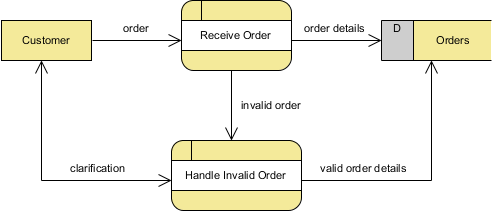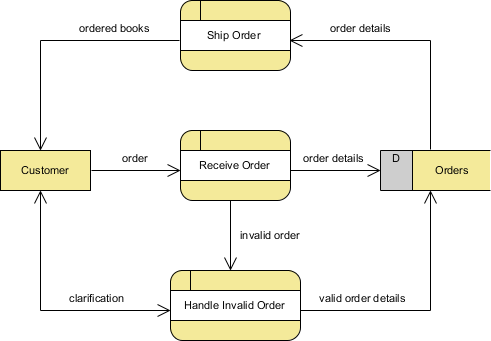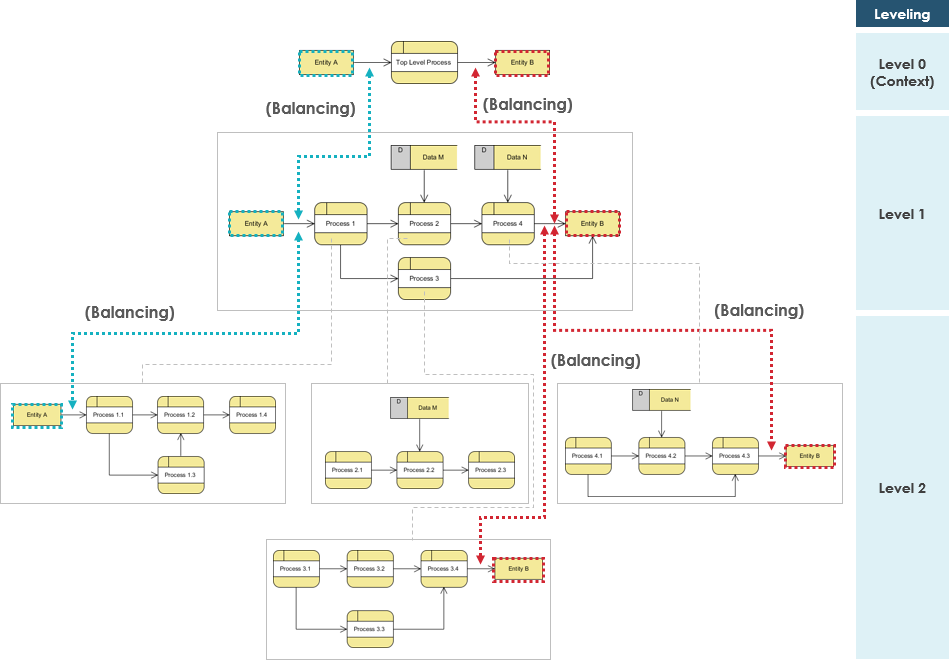Navigating System Complexity: A Comprehensive Guide to Data Flow Diagram Levels
Introduction
In the intricate landscape of software engineering, Data Flow Diagrams (DFD) emerge as indispensable tools for unraveling the intricacies of system functionality. These graphical representations come in distinct levels, each peeling back layers of complexity.
Levels of DFD
Let’s embark on a journey through the three pivotal levels of DFD: Level 0 DFD, Level 1 DFD, and Level 2 DFD.
1. Level 0 DFD: The Grand Overview
At the zenith of abstraction stands the Level 0 DFD, aptly termed the context diagram. This panoramic view provides an encompassing glance at the entire system. Major processes, data flows, and data stores are portrayed without delving into the minutiae of internal operations. Represented as a singular bubble, the system engages with external entities through meticulously labeled incoming and outgoing arrows, offering a simplified yet holistic perspective.

2. Level 1 DFD: Deciphering Complexity
Descending into the depths of intricacy, the Level 1 DFD dissects the major processes identified in the Level 0 DFD into sub-processes. Each sub-process metamorphoses into a discrete entity, vividly portrayed on the Level 1 DFD, complete with associated data flows and data stores. This level introduces granularity, spotlighting primary functions and deconstructing high-level processes for a nuanced analysis.

3. Level 2 DFD: Unveiling Precision
Continuing the odyssey into complexity, the Level 2 DFD plunges even further, breaking down the sub-processes identified in the Level 1 DFD. Each sub-process emerges as a distinct entity, meticulously outlined on the Level 2 DFD, accompanied by intricately mapped data flows and data stores. This level serves as a blueprint for planning and recording specific details about the system’s functioning, providing a comprehensive roadmap for developers and analysts.

Top-Down Decomposition Explained:
Top-down decomposition is synonymous with leveling, and it serves as a systematic approach to delve into the finer details of a system. This technique involves the creation of a series of DFDs, each offering a deeper and more intricate perspective than the previous one. The process initiates by presenting the targeted system as a singular process in the highest-level DFD. Subsequent diagrams then unfold, gradually revealing more details until each process becomes a functional primitive.
Imagine the top-down decomposition as peeling the layers of an onion. Each layer exposes a more detailed and granular understanding of the system’s processes, data flows, and data stores. This systematic breakdown aids in comprehending the system at various levels of intricacy, facilitating effective analysis and design.
Balancing DFD: Ensuring Consistency Across Levels:
As top-down decomposition progresses to lower-level DFDs, maintaining consistency in inputs and outputs becomes imperative. This crucial step is known as balancing DFD. The idea is to ensure that the inputs and outputs between consecutive levels (n and n+1) remain unchanged. In other words, the lower-level DFD should conserve the same inputs and outputs as its higher-level counterpart.
This meticulous balancing act is vital for preserving the integrity and coherence of the system representation across different levels. It ensures that the refined details added in the lower-level DFDs align seamlessly with the broader overview presented in higher-level DFDs. By conserving inputs and outputs, the transition between levels remains smooth, providing a coherent narrative of the system’s intricacies.
Advantages of Harnessing Data Flow Diagrams (DFD)
- Accessible Comprehension: DFDs offer a visually intuitive representation, catering to both technical and non-technical stakeholders.
- Enhanced System Analysis: Aiding in the scrutiny of processes and data flow, DFDs prove instrumental in identifying inefficiencies and redundancies.
- Architectural Support: DFDs contribute significantly to the design of a system’s architecture and structure, aligning with stakeholder requirements.
- Testing and Verification Facilitation: By identifying system inputs and outputs, DFDs streamline the testing and verification of functionality.
- Effortless Documentation: The visual appeal of DFDs simplifies documentation and maintenance of the system over time.
Drawbacks of DFDs:
- Tempo of Creation: Crafting DFDs, especially for intricate systems, may consume substantial time.
- Focused Scope: DFDs primarily emphasize data flow and might overlook critical aspects such as user interface design or system security.
- Maintenance Challenges: DFDs risk becoming outdated as systems undergo evolution and change over time.
- Technical Expertise Requirement: While user-friendly in comprehension, the creation of DFDs demands a level of technical expertise and familiarity with the system under scrutiny.
Conclusion
The virtues of utilizing DFDs — enriched understanding, streamlined system analysis, design fortification, testing facilitation, and documentation ease — outweigh the limitations. However, it remains imperative to recognize these constraints and synergize DFDs with additional tools and techniques for a holistic analysis and design approach to intricate software systems.
In summary, top-down decomposition techniques offer a structured and systematic approach to understanding complex systems. Through a series of progressively detailed DFDs, this method unveils the inner workings of a system. Balancing DFDs, in turn, ensures consistency in inputs and outputs across different levels, preserving the integrity of the system representation. As a dynamic duo, these techniques empower analysts and designers to navigate the complexities of system architecture with precision and clarity.


